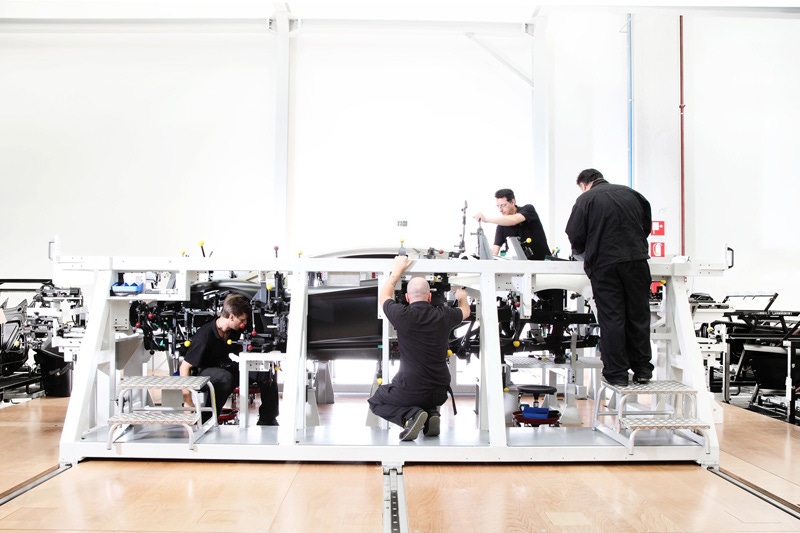Lamborghini Looks to Cut Emissions, Improve Fuel Economy as Sales RiseLamborghini Looks to Cut Emissions, Improve Fuel Economy as Sales Rise
Audi’s fully owned Italian subsidiary makes extensive use of the German parent’s expertise in advanced lightweight engineering, particularly in the high-volume application of aluminum.

Lamborghini sales are on the rise, up 30% last year compared with prior-year, to 2,083 units, and similar volumes are expected for 2013, the Italian supercar maker’s top executive says.
Stephen Winkelmann, president and CEO of Lamborghini, says demand for the high-end sports car is being fueled by the Aventador and Gallarado model lines, as well as an emerging wealthy class in developing markets.
Although the U.S. remains Lamborghini’s largest market, followed by China, Winkelmann tells WardsAuto the auto maker is enjoying a sales boost in Japan, Indonesia and the Middle East.
“Those are the biggest markets seeing the biggest growth,” he says, noting China accounts for 15% of Lamborghini’s global sales, (but) “the supercar market (there) is pretty small and we’re not seeing a big increase.”
Lamborghinis, which can top 200 mph (322 km/h) and accelerate to 60 mph (97 km/h) in less than 3 seconds, are marketed to just a handful of ultra-rich buyers, yet the auto maker faces some of the same challenges as mainstream brands, such as reducing emissions and improving fuel economy. A tough task for cars powered by V-12 and V-10 engines making nearly 700 hp.
To achieve this goal, Lamborghini is using lightweight materials in its vehicles. Given the brand’s high price tag – the Aventador starts at $397,500 – the auto maker is able to make liberal use of expensive carbon fiber and aluminum.
Audi’s fully owned subsidiary also has access to the German parent’s expertise in advanced lightweight engineering, particularly high-volume applications of aluminum that Lamborghini uses in areas such as spaceframe construction of the Gallardo model range.
Both auto makers have expertise in fiber-reinforced composite materials. Lamborghini’s contribution to the partnership includes decades of experience with carbon fiber in the development and production of low-volume models. Audi currently is working with a variety of lightweight materials for a hybrid concept vehicle.
“We have used carbon fiber for more than 30 years,” Winkelmann says. “It helps us reduce the weight of the Aventador dramatically. It’s very light and a material that fits perfectly for our brand.”
Lamborghini shares little with other Volkswagen Group brands, although that may change in the future.
“We have our own platforms,” with the exception of the Audi R8 and Lamborghini Gallardo, which share the same aluminum spaceframe, Winkelmann says. “A super sports car is about DNA. (Sharing with VW) might come up in future models, but not at the time being.”
Lamborghini’s effort to cut carbon-dioxide emissions includes the introduction of a stop/start system and cylinder-deactivation in the Aventador LP 700-4. However, there are no plans for a hybrid-electric powertrain for any of the marque’s models.
“We’re now working on naturally aspirated engines,” Winkelmann says. “(Lamborghini owners) don’t drive their car from A to B, because they want to enjoy the drive. We always keep a balance of the DNA of the brand and emissions.”
Lamborghini is cutting emissions at its production facility in Sant'Agata Bolognese, Italy, as well, installing solar panels that will generate electricity. “We will be CO2-neutral by 2015, and want to reduce CO2 emissions in our cars 30%,” he says. “We’re on our way to achieving those goals.”
Lowering emissions and improving fuel economy may not matter to Lamborghini’s wealthy clientele, who likely don’t worry about rising fuel prices. But Winkelmann says it’s the right thing to do for the environment and to meet increasingly strict global standards.
Lamborghini only builds a few models, including special editions of the Aventador and Gallarado. Plans to produce an SUV were scuttled by Audi’s parent, Volkswagen Group, which instead approved the project for Bentley.
Lamborghini produced an SUV in the past, the LM002 in 1986, but it did not sell well and was discontinued. Winkelmann says such a model still is in the works at Lamborghini, although there is nothing more he can disclose about the plan.
About the Author
You May Also Like

